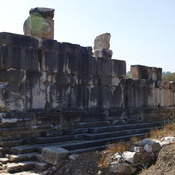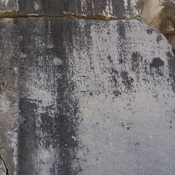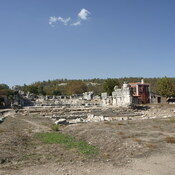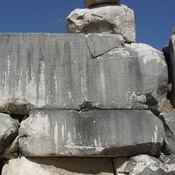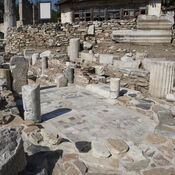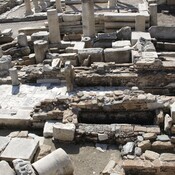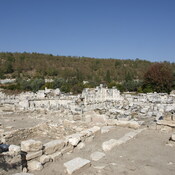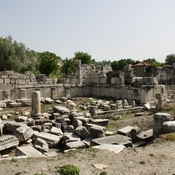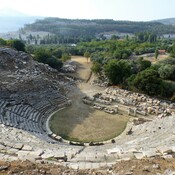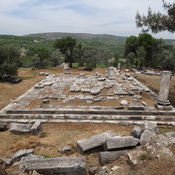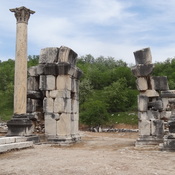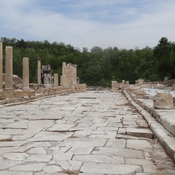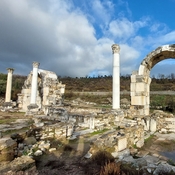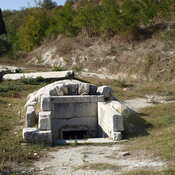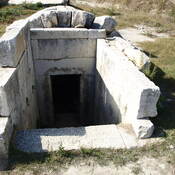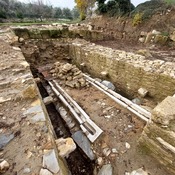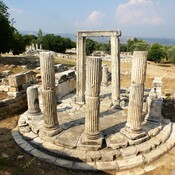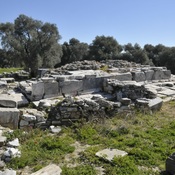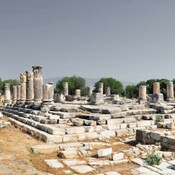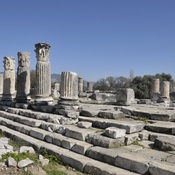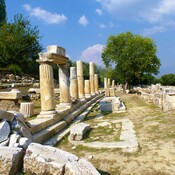Es gibt noch keine deutschsprachige Anmerkungen. Präsentiert wirden Anmerkungen auf English.
Stratonicea was a city in the interior of Caria, built on a fertile plain near the sources of Marsyas River.
Stratoniceia is a settlement of Macedonians. And this too was adorned with costly improvements by the kings. There are two temples in the country of the Stratoniceians, of which the most famous, that of Hecatê, is at Lagina; and it draws great festal assemblies every year. And near the city is the temple of Zeus Chrysaoreus,41 the common possession of all Carians, whither they gather both to offer sacrifice and to deliberate on their common interests. p299 Their League, which consists of villages, is called "Chrysaorian." And those who present the most villages have a preference in the vote,42 like, for example, the people of Ceramus. The Stratoniceians also have a share in the League, although they are not of the Carian stock, but because they have villages belonging to the Chrysaorian League. Here, too, in the time of our fathers, was born a noteworthy man, Menippus, surnamed Catocas, whom Cicero, as he says in one of his writings,43 applauded above all the Asiatic orators he had heard, comparing him with Xenocles and with the other orators who flourished in the latter's time1.
According to Stephanus of Byzantium the city was named in honour of Stratonice, the spouse of Antiochus I. It is udoubtedly a Helelnistic city dates to the Seleucids build according to the ruleof Hippodamian plan.
- George E. Bean, Turkey Beyond the Maeander. An Archaeological Guide, London Ernest Jersey 1971, p. 88-93
- Strabo, Geography, xiv. 2
- Stephanus of Byzantium, Ethnica, s.v. "Stratoníkeia"
- http://whc.unesco.org/en/tentativelists/6041/
- Stratonicea in The Catholic Encyclopedia - http://www.newadvent.org/cathen/14315a.htm
- http://asiaminor.ehw.gr/forms/fLemmaBodyExtended.aspx?lemmaID=10061
- S. Corcoran, The Heading of Diocletian's Prices Edict at Stratonicea, Zeitschrift für Papyrologie und Epigraphik , 166 , 2002, pp. 295-302 - http://www.academia.edu/1925882
- Vasıf Şahoğlu, Hayat Erkanal, Vasıf Şahoğlu, Rıza Tuncel, Ourania Kouka, Levent Keskin, İrfan Tuğcu,“2008 Yılı Liman Tepe Kara Kazıları”. 31. Kazı Sonuçları Toplantısı Bildirileri Cilt 4, 2010, 347-360.
Referenzen
- ↑Strabo XIV..2.25
Stratonicea was a city in the interior of Caria, built on a fertile plain near the sources of Marsyas River.
Stratoniceia is a settlement of Macedonians. And this too was adorned with costly improvements by the kings. There are two temples in the country of the Stratoniceians, of which the most famous, that of Hecatê, is at Lagina; and it draws great festal assemblies every year. And near the city is the temple of Zeus Chrysaoreus,41 the common possession of all Carians, whither they gather both to offer sacrifice and to deliberate on their common interests. p299 Their League, which consists of villages, is called "Chrysaorian." And those who present the most villages have a preference in the vote,42 like, for example, the people of Ceramus. The Stratoniceians also have a share in the League, although they are not of the Carian stock, but because they have villages belonging to the Chrysaorian League. Here, too, in the time of our fathers, was born a noteworthy man, Menippus, surnamed Catocas, whom Cicero, as he says in one of his writings,43 applauded above all the Asiatic orators he had heard, comparing him with Xenocles and with the other orators who flourished in the latter's time1.
According to Stephanus of Byzantium the city was named in honour of Stratonice, the spouse of Antiochus I. It is udoubtedly a Helelnistic city dates to the Seleucids build according to the ruleof Hippodamian plan.
- George E. Bean, Turkey Beyond the Maeander. An Archaeological Guide, London Ernest Jersey 1971, p. 88-93
- Strabo, Geography, xiv. 2
- Stephanus of Byzantium, Ethnica, s.v. "Stratoníkeia"
- http://whc.unesco.org/en/tentativelists/6041/
- Stratonicea in The Catholic Encyclopedia - http://www.newadvent.org/cathen/14315a.htm
- http://asiaminor.ehw.gr/forms/fLemmaBodyExtended.aspx?lemmaID=10061
- S. Corcoran, The Heading of Diocletian's Prices Edict at Stratonicea, Zeitschrift für Papyrologie und Epigraphik , 166 , 2002, pp. 295-302 - http://www.academia.edu/1925882
- Vasıf Şahoğlu, Hayat Erkanal, Vasıf Şahoğlu, Rıza Tuncel, Ourania Kouka, Levent Keskin, İrfan Tuğcu,“2008 Yılı Liman Tepe Kara Kazıları”. 31. Kazı Sonuçları Toplantısı Bildirileri Cilt 4, 2010, 347-360.
Referenzen
- ↑Strabo XIV..2.25

